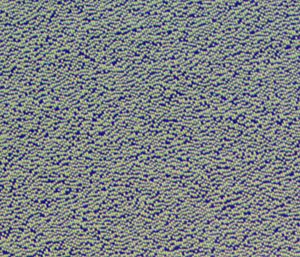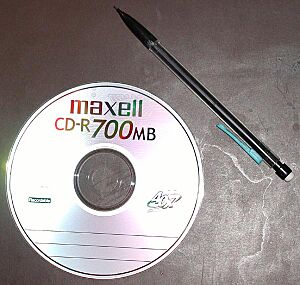CD facts for kids
A CD most commonly means a Compact disc. A Compact Disc is a flat, round disc that stores digital information. This information can be music, computer programs, or other data. CDs were very popular for listening to music and storing computer files for many years.
Contents
What is a Compact Disc?
A Compact Disc, or CD, is a type of optical disc. This means it uses light, specifically lasers, to read and write information. CDs are usually 12 cm (about 4.7 inches) in diameter. They are made of polycarbonate plastic and have a thin layer of aluminium or gold. This layer holds the digital data.
How CDs Store Information
CDs store information as tiny bumps and flat areas on their surface. These are called "pits" and "lands." When a CD player reads the disc, a laser beam shines on these pits and lands. The way the light reflects back changes depending on whether it hits a pit or a land. A sensor in the player detects these changes. These changes are then turned into digital signals. These signals become the music you hear or the data your computer uses.

Types of CDs
There are a few main types of Compact Discs:
- CD-DA (Compact Disc Digital Audio): This is the original type of CD. It was designed specifically for storing music. You would buy these CDs in stores to listen to your favorite songs.
- CD-ROM (Compact Disc Read-Only Memory): These CDs store computer data. "Read-Only Memory" means you can only read the information from the disc. You cannot save new information onto it. CD-ROMs were used for software, games, and encyclopedias.
- CD-R (Compact Disc Recordable): With a CD-R, you can record your own data or music onto the disc once. After you record it, you cannot erase or change it. Many people used CD-Rs to make custom music mixes or back up files.
- CD-RW (Compact Disc ReWritable): These CDs allow you to record, erase, and re-record data multiple times. This made them more flexible for saving files that might change often.
The History of Compact Discs
The Compact Disc was developed by Philips and Sony. It was first introduced in 1982. Before CDs, most music was stored on vinyl records or cassette tapes. CDs offered much clearer sound quality and were more durable. They quickly became the main way people bought and listened to music.
CDs Today
While CDs are still used, their popularity has decreased. This is because of new technologies like digital downloads and music streaming. Many people now listen to music online or store it on their phones. However, some people still collect CDs for their sound quality or as collector's items.
Other Meanings of CD
The letters "CD" can also stand for other things, though they are less common than Compact Disc:
- Certificate of Deposit: This is a type of savings account offered by banks. You agree to keep your money in the bank for a set period, and in return, the bank pays you a fixed amount of interest.
Images for kids
See also
 In Spanish: Disco compacto para niños
In Spanish: Disco compacto para niños




